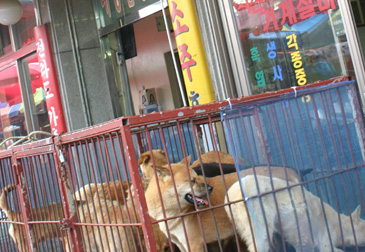Moran Market S.Korea’s Center for Dog Meat- A Seoul Times Article By Thaddeus & Megan
Dog meat awaits customers in a shop in S. Korea’s Moran Market.
An Article co-written by Thaddeus & Megan for The Seoul Times
http://www.theseoultimes.com
National
Moran Market, S. Korea’s Center for Dog Meat
Dogs Are Farmed, Raised for Eating in S. Korea
By Megan Fox
Staff Writer
Food and eating cultures differ around the world. In many countries people have a type of meat that is tied specifically to their culture. In Peru locals eat Guinea pig, in China it’s cat, horse in Italy, and strangely many westerners, in addition to eating the meat, choose to drink the mammary products of bovines, cow milk. Foreigners have often looked on with disbelief as “strange” animals are consumed by other cultures.
However, in our ever more globalized world, the pressure of outside influences on those native dining habits have begun to be felt. This is particularly true of dog meat in South Korea. In a quest to learn more about this increasingly polarizing topic, we decided to take a trip to the Moran Market east of Seoul to see the practice for ourselves.
Dog meat consumption has occurred in many parts of the world, in Eastern and Western countries alike. In Korea the practice of eating dog has been common for centuries. The meat is eaten year round, most commonly in summer time. It is believed by many that eating dog can bring virility and can cure many ailments. Jin Kim grew up in Korea and, throughout his childhood, eating dog meat was a normal practice. “My family would often eat dog meat during summer trips to the country to see my grandparents.
 |
| Live dogs are waiting to be slaughtered for meat or soup at a shop in S. Korea’s Moran Market in Seongnam City. |
The food is very healthy. It helps give a long life, clear skin and clean body. It also is filling. If you eat dog, you can skip two meals following. In the summer months dog meat will cool your body.” Though these traditional beliefs were once widespread, it is unlikely that the benefits of dog meat differ greatly from those of other lean red meats like venison.
The primary breed of dog that is farmed and raised for eating is the Nureongi. This large breed differs from the dogs that are kept for pets in Korea and reminded me somewhat of a domesticated dingo. Their hair is short and yellow, and they had a very uniform appearance. Dog meat itself is prepared in several ways. It is commonly boiled and eaten in a stew, but can also be steamed or grilled.
In addition to the debate over the practice of eating dog meat, there is also much debate about the manner of death for dogs raised as livestock. Some people have asserted that dogs are often killed by repeatedly hitting them with a long stick. This practice may have been done in the belief that a ‘many hit killing’ might make the flesh meat become tender. Although others discount this theory pointing to the common belief among western livestock slaughterers that pain prior to death leads animals’ meat to become tainted by adrenaline and, therefore, of much lower quality.
Azumi Sugimoto is an expat from Japan that has been living in Korea for 13 years. “I do not personally eat dog meat because it is not part of my culture. I understand that it is part of the Korean culture and do not take offense to the consumption of dog meat by Korean people. I do not, however, support the killing of dogs brutally. Hitting a dog many times before death is tragic.”
As South Korea becomes increasingly globalized, many people are making the personal choice not to eat dog meat. A Korean national study revealed that 59% of Koreans under the age of 30 would not consume dog meat. 62% believe that dogs are pets and not food. A growing percentage is actively seeking to take action against this practice. In recent years, animal activist groups have sprung up throughout Korea. Narmia Lee, a Korean in Seoul, wants to see an end to the consumption of dog meat: “Many parts of me say, who are we to distinguish what animals are okay to eat and what aren’t? But animal cruelty is my main issue with this. The dogs are treated terribly before being slaughtered. There is no regulation of how the animals are cared for prior to their death since these are all illegal farms. These dogs must be treated and killed humanely during their lifetime.”
While we discovered a near universal agreement on the necessity of humane treatment for these animals, the dog farm industry remains relatively independent of oversight and seemingly underground due to its tenuous legal status. Some have argued that the best way to enforce humane treatment is to fully legalize the trade so that there can be additional oversight. This notion bears some resemblance to the way prostitution is partially legalized in many European countries.
If oversight is provided, then the question becomes more about what is acceptable for these dogs other than euthanasia. It is much easier to judge when looking at our relationships with our own pets, but many westerners fail to realize that millions of dogs are euthanized each year to control the pet population, and their meat is simply wasted.
While the practice of eating dogs as meat is considered socially unacceptable, some 5 to 7 million companion animals are placed in shelters, waiting for a home, each year. According to the animal activist foundation, ASPCA, 3 to 4 million dogs and cats don’t find a home and are euthanized each year in the United States of America. This is 60 percent of the dog population in America.
In the interest of learning more about this topic we decided to take a trip to Moran market, the largest market for dog sales in South Korea. It is located in Seoul’s southeastern corner and open on days of the month ending in 4 and 9. Here dogs are on display in clean cages. Butchered meat is sold by the piece in front of the living animals. On a recent trip to the market, over 500 dogs were on display in cages. The cages seemed hygienic, and dogs were kept fed and watered. Ironically, puppies and kittens are sold as pets about 50 meters away in the very same part of the market.
While we were expressly instructed not to take pictures by many of the workers in the area, it was clear that this was not an unhygienic underground practice, as is occasionally asserted. Instead it appears to be a relatively open and sanitary one. Still, our trip to the dog meat portion of the Moran Market left us feeling disinclined to partake of it ourselves. The visit also made it easier to understand the domestication and processing of dogs for food after witnessing the rows of uniformed cages, very similar to that of any other form of commonly eaten livestock. If anything, the experience made us both think that the other animals for sale to be slaughtered there, like ducks and chickens, were in many ways just as pitiable as the dogs. Ironically, we frequently consume the meat from these animals and have no intention of stopping. In the end we learned that once you’ve seen something with your own eyes and gain a clearer understanding of it, previously formed convictions are challenged and become open to serious reflection, and perhaps to change.
The above story was written by Megan & Thaddeus Fox.


